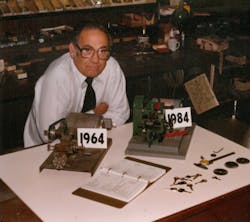The Framon #2 Code Machine has been a favorite in the locksmith industry for more than 50 years. It still is one of the company’s most popular machines and always good fodder for the discussion between its users and the other code machines available to today’s locksmith.
The “Key Cutter” patent was issued to Frank Agius on May 20, 1975, with a filing date of June 1, 1971. It started as a homemade machine really intended for Agius’ use only. In 1964, when he started to take Leonard Singers’ locksmithing correspondence courses, Agius simply was looking for something to make his life a bit easier, literally stealing parts off the utility sink in the family house.
His supplier, Sam Solomon, heard about the invention and urged Agius to market the machine. The small machine blossomed into a full-fledged company that eventually would take Agius to every corner of the globe, selling the machine and teaching classes to locksmiths everywhere.
Quality is Key
All history aside, the #2 was borne out of the machine shop where Agius spent many years. A spacing dial to control cuts along the key blade laterally and a depth micrometer to adjust depth of cut were essential features.
Agius never was one to skimp on quality. After the machine went into production, sealed ball bearings were used extensively, and an all-aluminum and steel chassis was a must. Over the years, Framon has heard dozens of stories of the machine falling off a bench or being ejected from a vehicle in a crash, only to be brushed up and able to cut a perfect key after. One of Agius’ selling points at trade shows was to drop the machine on the floor in front of interested customers, pick it up and cut a working key.
A primary component of the #2 is its straight-in feed. Agius never finished high school but had a great understanding of precision machining, knowing that a perfect cut would be made only by feeding the key straight into the cutter instead of on a pivot, as with many other machines. The straight-in feed of the machine remains one of the primary selling points of the #2.
The #2 has been offered with varying combinations of accessories over time. This year, the flagship model has been repackaged with six spacing blocks, the Depth & Space Manual, an FC8615 Medeco cutter, an FC8445 standard cutter, dial calipers, Genericode code software and adjustment tools. With the new package also came a new lower price.
Combining the #2 with Framon’s powerful Genericode software enables the user to originate almost any standard edge-cut key currently in use. The display of Gcode gives the user all of the measurements necessary to start cutting a key without searching for a card.
Accuracy Figures In
Accuracy always has been a benchmark with the #2. The machine is able to cut to within 0.0005 inches in depth.
Another great feature of the machine is that the depth is set away from the key blank. The user sets the depth then feeds the key into the cutter, eliminating the possibility of going too far in and ruining the key.
With this in mind, particularly when cutting automotive keys, there is no need to reset the depth nine times when cutting a key that has 10 spaces, such as a General Motors ten-cut key. Set the machine to the first depth (for example, a No. 2 depth of 0.290 inches) and make your cut. Instead of resetting the depth for the next cut on the key, simply turn the spacing dial to each space where a No. 2 depth has to be made. This speeds up the cutting process, allowing the user to produce the key by changing the depth only three times, and if the No. 1 depth is a no cut, only twice.
A standout feature of the #2 (although rarely used) is its ease of adjustment. If the machine ever requires adjustment to the depth setting, simply set the machine to a known depth (for example, 0.300 inches) and make a cut on a key. (Framon suggests Kwikset or Dexter, because the key blade is centered.) Measure the cut by using the included dial calipers, which read accurately. If the calipers read 0.305 inches, simply make the dial on the #2 read the same by loosening the allen screw and rotating the dial to the “5” indicator. Retighten the allen screw on the dial, and the machine is adjusted.
Keys such as Kwikset, Weiser and some interchangeable cores will require either a special cutter or a widening of the cuts. With the #2, it’s easy to save money on an extra cutter by just turning the spacing dial a few thousandths of an inch left or right after the cut is made.
Keep in mind that widening the cuts is necessary only when using factory pins. Lab .003 and .005 pins fit perfectly in the cut made by the standard FC8445 cutter that’s furnished with the #2.
Over the years, the #2 has seen a few different paint jobs (from green to blue to black), but the core of the machine remains the same as it was in 1964 — a highly accurate, robust machine able to generate almost any cylinder key in use.
Contact Framon at 989-354-5623 or your distributor for more information. You also can email [email protected] or visit the website, www.framon.com.
Phil Agius is vice president, sales at Framon Manufacturing Co. and Frank Agius’ son.
